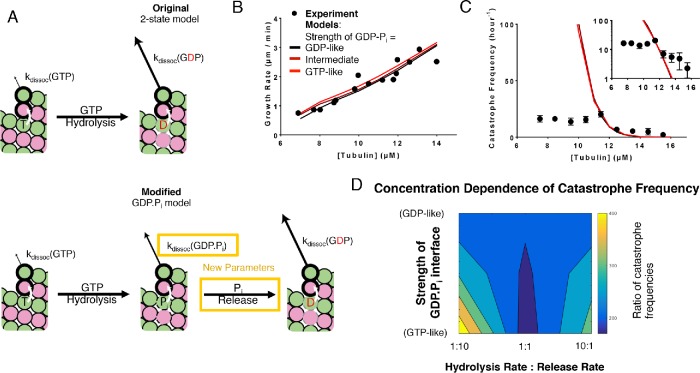FIGURE 2:
Three-state model that contains a GDP.Pi intermediate. (A) Cartoons illustrating the differences between models without (top) and with (bottom) a GDP.Pi intermediate. The GDP.Pi intermediate requires two additional parameters: a rate constant for Pi release and another for the strength of the longitudinal interaction when GDP.Pi is at the interface. Vertical white arrows indicate trans-acting nucleotides. (B) Comparison between measured (black circles) and predicted (lines; red, black correspond to GDP.Pi interfaces having the same strength as GTP and GDP interfaces, respectively; brown corresponds to GDP.Pi interfaces having intermediate strength) growth rates. All three scenarios can recapitulate observed growth rates. In this plot the ratio between the hydrolysis rate and the phosphate release rates has been set to 1:1. (C) Predicted catastrophe frequency as a function of concentration for different values for the strength of the GDP.Pi longitudinal interface. Varying the strength of the GDP-Pi interface has a limited effect on the concentration dependence of the catastrophe frequency. The ratio between the hydrolysis rate and the phosphate release rates has been set to 1:1. The y-axis is linear in the larger plot. The smaller inset graph displays the same data, but the y-axis is on log scale. (D) Contour plot of the predicted concentration dependence of catastrophe. The concentration dependence is defined as the ratio of catastrophe frequencies at 9.5 and 13.5 µM. The concentration dependence of the catastrophe frequency is lowest when the ratio between hydrolysis and release is 1:1 and the longitudinal interface with GDP-Pi is as strong as the interface with GTP.

